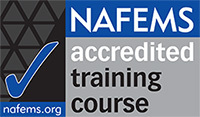| ID | Competence Statement |
| FEAkn1 | List the various steps in the analysis/simulation process.
|
| FEAkn2 | Define the meaning of degree of freedom.
|
| FEAkn3 | List the nodal degrees of freedom and the associated force actions for common beam, 2D solid, 2D axisymmetric, 3D solid and shell elements, for the Displacement FEM.
|
| FEAkn8 | List the requirements for an axisymmetric analysis to be valid.
|
| FEAkn9 | List the degrees of freedom to be constrained on a symmetric boundary.
|
| FEAkn11 | Sketch problems showing the various form of symmetry.
|
| FEAkn12 | List the advantages of using symmetry.
|
| FEAkn14 | List the possible advantages of applying material properties, loads and boundary conditions to underlying geometry rather than to finite element entities.
|
| FEAkn15 | List 2 common solvers for large sets of simultaneous equations.
|
| FENkn16 | List the various forms of element distortion.
|
| FEAkn17 | List the various element types commonly used in the analysis of components within your organisation.
|
| FEAco1 | Describe the sources of error inherent in finite element analysis, in general terms.
|
| FEAco2 | Discuss checks that may be used post-solution to check for the presence of inaccuracy.
|
| FEAco4 | Explain the meaning of convergence, including h and p types.
|
| FEAco5 | Discuss the difficulties that can arise in using a CAD model as the basis for carrying out analysis and simulation.
|
| FEAco6 | Discuss the need for a consistent set of units in any analysis and illustrate possible pitfalls.
|
| FEAco7 | Explain why strains and stresses are generally less accurate than displacements for any given mesh of elements, using the Displacement FEM.
|
| FEAco11 | Discuss the finite element / spring analogy.
|
| FEAco12 | Outline a common method employed to solve the large sets of sparse symmetric common in FEA.
|
| FEAco13 | Explain how the structural stiffness matrix is assembled from the individual element matrices.
|
| FEAco14 | Discuss the nature of the structural stiffness matrix.
|
| FEAco18 | Explain the term Isoparametric Element.
|
| FEAco24 | Discuss the relationship between shape function and strain/stress prediction for simple 2D linear and parabolic elements.
|
| FEAco26 | Discuss the significance of computer memory to solution elapse time for large models.
|
| FEAco27 | Explain how unwanted cracks can be produced in 2D and 3D solid meshes and describe which plot type is useful in detecting these.
|
| FEAco28 | Explain why element distortion generally results in poorer results.
|
| FEAco29 | Discuss the term Flying Structure or Insufficiently Constrained Structure.
|
| FEAco30 | Explain why stress averaging is not appropriate at junctions between elements of different thickness.
|
| FEAco31 | Explain why most finite elements do not represent a circular boundary exactly and highlight how this approximation manifests itself.
|
| FEAco35 | Discuss the terms Validation and Verification and highlight their importance.
|
| FEAco40 | Explain the rationale behind the use of 1-D, 2-D and 3-D elements used in the analysis of components within your organisation.
|
| FEAap1 | Employ an analysis system for the determination of stresses and strains in small displacement, linear elastic problems.
|
| FEAap2 | Demonstrate effective use of available results presentation facilities.
|
| FEAap3 | Illustrate the approximate nature of finite element analysis, through examples chosen from your industry sector.
|
| FEAap4 | Illustrate the various steps in the Displacement Finite Element Method from assumed displacement polynomial to determination of stresses.
|
| FEAap5 | Illustrate possible applications of 0D, 1D, 2D and 3D elements in your industry sector.
|
| FEAap7 | Employ symmetric boundary conditions effectively.
|
| FEAap10 | Illustrate various physical situations which will result in a Stress Singularity and explain why it is not appropriate to use finite element results at such locations directly.
|
| FEAap12 | Employ a range of post-solution checks to determine the integrity of FEA results.
|
| FEAan1 | Analyse the results from small displacement, linear static analyses and determine whether they satisfy inherent assumption
|
| FEAan2 | Compare the results from small displacement, linear elastic analyses with allowable values and comment on findings.
|
| FEAev2 | Assess the significance of neglecting any feature or detail in any idealisation.
|



